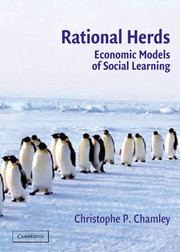15 - Gaussian Financial Markets
Published online by Cambridge University Press: 12 January 2010
Summary
Buy low or when the price is rising?
In a CARA–Gauss setting, the demand for the asset is similar to the demand for investment in a quadratic model, with the important difference that the cost is endogenous to the information revealed by others. Two models of trade are considered: (i) limit orders are net demand schedules, which are contingent on the information revealed by the price; social learning does not slow down when more agents trade; (ii) market orders specify fixed quantities (rationally determined); social learning slows down by the same mechanism as in the model of Vives (1993) in Chapter 3.
In this chapter, a financial market is modeled according to a standard structure: a large number of agents, each with a net demand curve, meet the market, and an auctioneer clears the market with an equilibrium price. The structure of the CARA– Gauss model is based on a utility with constant absolute risk aversion of agents and Gaussian random variables. It is presented here from first principles. This model has been studied extensively because of its nice properties. The purpose of this chapter is to relate some of the properties of the CARA–Gauss model to other models of social learning in this book.
INDIVIDUAL ACTIONS
In previous chapters, actions conveyed private informations to others. In a financial market, these actions are the trades. Section 15.1 emphasizes how the information of an agent about the value of an asset (the unobservable state of the world) affects his demand for the asset.
- Type
- Chapter
- Information
- Rational HerdsEconomic Models of Social Learning, pp. 330 - 357Publisher: Cambridge University PressPrint publication year: 2003



